| Article ID | Journal | Published Year | Pages | File Type |
|---|---|---|---|---|
| 8365192 | Soil Biology and Biochemistry | 2013 | 10 Pages |
Abstract
In semiarid climates, soils are often found in pre-desertic states with constrained vegetation, organic matter and ecosystem functionality. These limitations negatively impact soil microbial communities which are important drivers of biogeochemical processes and strongly influence soil quality. The long-term impacts of restoration on the phylogenetic structure and metabolic functionality of soil microbial communities were studied in a representative degraded field area located in southeast-Spain. Restoration was undertaken 25 years ago by the singly application of two doses of organic domestic waste at 65 Mg haâ1 (LD plots) and 195 Mg haâ1 (HD plots). Control soils without amendment were also evaluated. Pyrosequencing of 16S- and 18S-rRNA genes did not reveal significant differences in phylogenetic diversity between restored and control soils. However, principal coordinates analysis of unweighted Unifrac distances showed variation in the structure of bacterial and fungal communities of HD plots. The number of Alpha-proteobacteria sequences was higher in HD plots than in LD and control plots, while Actinobacteria abundance diminished in HD plots. In contrast to Basidiomycota, the number of Ascomycota sequences responded positively to restoration. Changes in microbial phylogenetic structure were related to changes in functional structure established by multivariate analysis of community-level-physiological profiles. Interestingly, despite the absence of phylogenetic diversity, restoration decreased the catabolic diversity in HD plots. This effect is likely due to the aboveground plant influences in restored plots. Overall, in the long-term, soil restoration under semiarid conditions did not increase microbial diversity but influenced microbial community structure and functionality.
Keywords
Related Topics
Life Sciences
Agricultural and Biological Sciences
Soil Science
Authors
Felipe Bastida, Teresa Hernández, Juan Albaladejo, Carlos GarcÃa,
